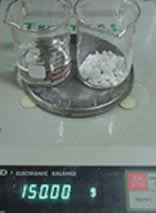Quite often the data collected
is in the form of a mass of numbers. Often these numbers need to be sorted
and a table is a quick way of doing this.
Tables have a:
-Heading or title.
-Units are written at the top of each column.
-All columns or lines are neatly drawn with a ruler.
Patterns are not so clear when looking at a table of data and so we must
graph them. Graphing the results gives a visual representation of the
data and makes it easy to notice trends or patterns.
Common chalk, used to write on blackboards, reacts with vinegar to produce carbon dioxide. We can measure how fast the reaction is progressing by measuring the mass of the beakers and all their contents. Since carbon dioxide is a gas it will escape and make the contents of the beaker lighter. This will give us a good idea of how fast the reaction is proceeding. Click to see 120kb video. Below is a table of results.

|
Mass
loss of a mixture of vinegar and chalk
|
|
|
Time(seconds)
|
Mass(grams)
|
|
0
|
150.00
|
|
15
|
148.25
|
|
30
|
147.15
|
|
45
|
146.85
|
|
60
|
146.22
|
|
75
|
145.90
|
|
90
|
145.71
|
|
105
|
145.63
|
|
120
|
145.60
|
Notice that the table has a:
-heading
-clearly labeled columns with units at the top.
-data neatly presented with straight columns and lines.
Lets present the information in a more visual form and produce a graph from this data.

All graphs must:
-have a heading
-have clearly labeled axis with the units
-have an even scale on each axis
-be neatly drawn
-all columns must be the same size as must all rows.
By presenting the data in this format we can see that the rate of the reaction, given by the slope of the mass loss versus time graph, slows down after 75 seconds and reaches a plateau.

A few pitfalls must be avoided when constructing graphs.
Firstly, it is important to
select the right scale for your axis. Notice how the graph looks different
when we alter the scale of the vertical axis.
It now looks as if no mass has been lost and the reaction is not taking
place. This is a very common problem and students should be aware of this.